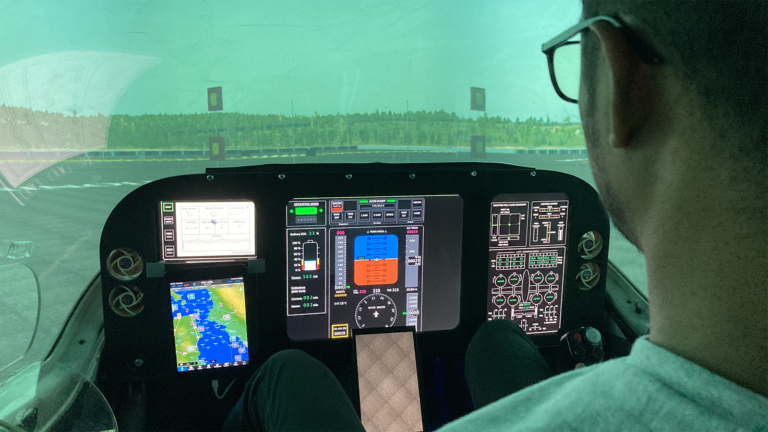Stay Up to Date
Submit your email address to receive the latest industry and Aerospace America news.
The Modeling and Simulation Technical Committee focuses on simulation of atmospheric and spaceflight conditions to train crews and support design and development of aerospace systems.
As part of the Artemis program, the Flight Simulation Facility at NASA’s Langley Research Center in Virginia designed the Lunar Flight Deck simulator to assess handling qualities during final approach and landing. During March and April, 10 participants conducted a human-in-the-loop, or HITL, study to evaluate how astronauts might visually assess landing zones via outboard windows and light detection and ranging scan data under varying conditions and display concepts.
In January, Systems Technology of California completed final HITL evaluations of its Adaptive Shipboard Guidance and Recovery Display, designed to mitigate rotorcraft accidents during low-visibility operations. All nine test pilots landed their simulated rotorcraft, referencing the symbology displayed on their cockpit screens to navigate under varying low-visibility conditions.
In July, advanced air mobility company Wisk Aero of California published a white paper describing its microsimulation platform, SCOPE. Short for Simulation, Coordination, Optimization, Planning, and Engagement, the software can simulate millions of real-world trips and model travel behavior in metropolitan areas powered by granular travel demand data, machine learning and large-scale graphics processing unit-based parallelization to help inform infrastructure design and policy decisions, which could help AAM aircraft concepts including Wisk’s air taxi begin passenger operations in the coming years.
At the beginning of the year, the Vehicle Systems, Dynamics, and Design Laboratory at Auburn University in Alabama configured two fixed-base flight simulators for an FAA-sponsored study focused on simplified vehicle operations for urban air mobility, a subset of AAM. One simulator was fitted with “airplane-centric” control inceptors and the other with “helicopter-centric” control inceptors. Both simulators will be used to study the fly-by-wire flight control system of a lift-plus-cruise electric vertical takeoff and landing concept. HITL simulations will involve tests with pilots with varying experience levels in a variety of scenarios to determine the effectiveness of flight control laws, inceptor mappings and cockpit displays for achieving simplified vehicle operations.
Between April and August, Virginia-based Mosaic ATM in partnership with North Carolina-based Smart Sky Networks and Ohio-based GE Aviation Services implemented a cloud flight management system, a digital twin of an onboard flight management system. If fielded, the twin would enable air traffic controllers on the ground to obtain current flight information, including weather data, and generate a common aircraft trajectory that can be shared across ATC automation platforms. This would allow air traffic controllers to test possible changes without impacting ongoing flights, thus enhancing situational awareness and safety.
In May, Optimal Synthesis of California released Version 2.0 of its Generalized National Airspace Traffic Simulation on Github, which simulates gate-to-gate trajectories, including both the airport surface movement and airborne phases, using aircraft dynamics and performance models. This release included aircraft interactions with ground vehicles, effects of the terrain profile on aircraft communication and navigation, and controller-pilot decision models.
Crown Consulting of Virginia this year received three Small Business Innovation Research awards from NASA. The first was a Phase II award in May, in partnership with UAM Geomatics of Virginia and Harris Miller, Miller and Hanson Inc. of Massachusetts, to develop an AAM Community Integration Platform to assist communities governments in planning how to integrate AAM aircraft and infrastructure into their local or regional transportation systems. The second was a Phase I award in July, in partnership with George Washington University, to develop a Vertiport Human Automation Teaming Toolbox to simulate vertiport airside operations with direct human manager oversight to identify effective human-machine teaming concepts. The third was a Phase I award in July, in partnership with the Universities Space Research Association of Maryland, to identify optimal routing that avoids contrails and captures emission considerations. This work will leverage machine-learning models based on NOAA data to predict contrail regions.
Contributors: Miguel Alvarez, Imon Chakraborty, Gano Chatterji, Mike Jones and Fred Wieland
Stay Up to Date
Submit your email address to receive the latest industry and Aerospace America news.




